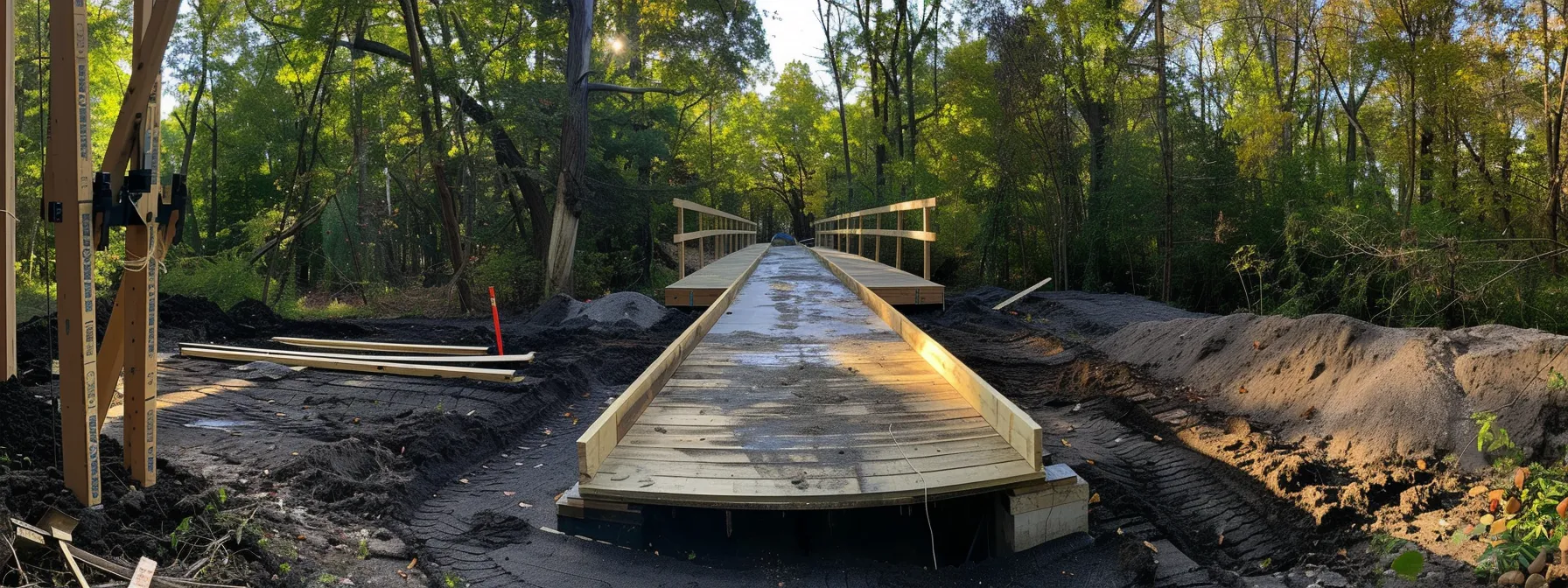
Navigating the complexities of ADA threshold height requirements is essential for property owners and developers focused on creating accessible environments. Ensuring adequate ADA door clearance not only facilitates movement for pedestrians but also enhances usability for individuals utilizing wheelchair ramps. Understanding these guidelines ensures compliance while promoting safety and comfort. Achieving the optimal balance between design and function invites important discussions about building accessibility. Keep reading to uncover essential insights into ADA threshold height regulations and solutions for common challenges.

Understanding the ADA threshold requirements is vital for ensuring accessibility in various settings, particularly in retail environments. These regulations establish specific height measurements that must be adhered to for thresholds ada door clearance, facilitating smooth transitions for individuals, including those who may face challenges when traversing between different surfaces. Compliance with these standards not only reflects a commitment to customer service but also avoids potential barriers that could resemble the restrictions found in a prison environment. By focusing on these key measurements, businesses can create welcoming spaces that accommodate every customer, making it as easy as pushing a button to access their services.
ADA threshold requirements, as outlined in the Americans with Disabilities Act of 1990, specify the maximum height for thresholds to ensure accessible transitions between surfaces. For example, in facilities with sliding doors or bathing areas, keeping threshold heights minimal prevents barriers for patients, particularly when navigating curbs or other changes in elevation. This adherence not only enhances accessibility but also fosters an inclusive environment for individuals with varying mobility levels.
Ensuring ADA compliance in threshold design is essential for creating spaces that accommodate everyone’s needs. A well-designed threshold, aligned with ADA standards, facilitates safe transitions for individuals entering a vehicle from a parking space or navigating a pier. Incorporating these considerations into architecture ensures that all users can comfortably access amenities, such as a table of contents for services, promoting inclusivity and enhancing overall experience.
The key measurements for ADA threshold heights must align with the specified guidelines to ensure smooth transitions in various building environments. For instance, thresholds at turnstiles or bathrooms should not exceed a height of ½ inch for vertical changes, while transitions from carpet to hard flooring may necessitate careful consideration to maintain efficiency without causing tripping hazards. Adhering to these measurements ensures that all individuals can navigate spaces comfortably, supporting an inclusive atmosphere in public and private facilities.
Having grasped the fundamental concepts of ADA threshold height, the next step is to examine the specific regulations that guide these measurements. This exploration will reveal the essential height and thickness requirements critical for compliance and accessibility.

The requirements around ADA thresholds focus on specific height limits and maximum thickness, ensuring safe and accessible transport between various surfaces. Adhering to these standards is crucial for creating spaces where customers can navigate effortlessly, especially those with mobility challenges. The guidelines also emphasize the importance of slopes and beveled edges, which are designed to eliminate abrupt changes that could hinder movement. By maintaining appropriate thresholds, facilities promote inclusivity, allowing individuals to traverse from sidewalks into buildings without obstacles that may pose risks, particularly for those who rely on assistive devices or may find themselves at knee level during transitions.
The specific height limits for ADA thresholds are critical in ensuring seamless transitions between different surfaces. For instance, thresholds must not exceed ½ inch in height, particularly at locations like curb cuts or nursing homes, where accessibility is vital. During renovation projects, special attention should be given to these measurements to guarantee all individuals can navigate spaces comfortably, whether entering through an elevator or moving from an outdoor area to an indoor environment.
The maximum thickness for thresholds as stipulated by the Americans with Disabilities Act (ADA) enhances accessibility while ensuring compliance with posted American National Standards Institute (ANSI) guidelines. These specifications dictate that the threshold must maintain an accessible height and thickness that accommodates overall lengths while avoiding abrupt changes that could impede navigation. Proper design and installation ensure that thresholds function effectively in conjunction with wall elements and access latch mechanisms, facilitating smooth transitions for all users.
| Criteria | Description |
|---|---|
| Maximum Thickness | Thresholds should not exceed specified thickness standards for seamless transitions. |
| Posted Guidelines | Compliance with ANSI standards ensures accessible design in various environments. |
| Wall Considerations | Integrating threshold design with wall elements enhances overall accessibility. |
| Latch Mechanisms | Threshold configurations should support functioning latch systems for safety and convenience. |
Guidelines for slope and beveled edges emphasize the importance of gradual transitions, particularly at walkways where individuals may navigate between surfaces. An appropriate ratio of slope, typically no greater than 1:12, ensures that any height changes, such as thresholds, remain accessible without exceeding an inch. This consideration is especially relevant in residential settings, such as moving from a bedroom to a hallway, where seamless design can significantly impact daily movement and safety.
Understanding the critical aspects of threshold height and thickness sets the stage for tackling real-world scenarios. Next, the focus shifts to navigating ADA compliance for existing and altered thresholds, ensuring accessibility for all.

Addressing the ADA threshold requirements in existing structures and during construction projects demands careful planning and execution. Retrofitting existing thresholds involves strategic adjustments to ensure compliance while enhancing accessibility for all. Understanding the specific ADA mandates for altering thresholds within buildings is imperative for maintaining a welcoming environment. Analyzing case studies showcasing before and after scenarios emphasizes the effectiveness of implementing these changes. These examples demonstrate how proper installation of handrails and other features can minimize pressure on individuals navigating transitions, ensuring that modifications bolster safety and usability in all spaces, including those resembling tunnels or compartments. The integration of functional locks further contributes to a seamless experience, reinforcing the commitment to accessibility throughout the process.
Retrofitting existing thresholds requires careful assessment of the force required to open a door while ensuring ADA compliance. Adjusting dimensions to meet accessibility standards is crucial, particularly in locations such as restrooms that include urinals. By prioritizing these modifications, facilities can create safe and convenient access, ultimately enhancing the experience for all users.
Altering thresholds in buildings involves adhering to specific ADA requirements aimed at enhancing access and minimizing discrimination. This includes ensuring that any changes account for the traffic flow, allowing individuals to navigate smoothly through entrances, whether into a room or gate. Attention to details such as diameter and incline can significantly improve accessibility for users requiring therapy and other forms of assistance.
Case studies highlight the transformative impact of adhering to ADA regulations in various environments. For instance, one facility improved its drinking fountain access by lowering the threshold leading to the area, enabling individuals with disabilities to navigate effortlessly from the main room. Another project focused on enhancing telecommunications access by redefining entry points, ensuring smooth transitions for all users, thereby promoting a more inclusive atmosphere.
As businesses strive to meet ADA compliance, the focus shifts towards optimizing access solutions. Techniques designed to minimize the opening force for ADA thresholds offer practical avenues to enhance accessibility and user experience.

Understanding the relationship between thresholds and door opening force is essential for ensuring compliance with ADA standards while promoting accessibility within various dwellings and commercial spaces. Minimizing the force required to open doors is imperative, particularly for individuals using wheelchairs or other mobility aids. By implementing effective strategies and utilizing specific tools and materials, property owners can create environments that align with legal requirements while enhancing the overall user experience. This approach not only fulfills the obligations set forth by law but also fosters an inclusive atmosphere, ultimately supporting employment opportunities for all individuals, regardless of their mobility challenges.
Thresholds play a critical role in the force needed to open doors, influencing overall usability for various users. An optimal threshold design allows for minimal resistance, which is especially important when considering accessibility features in settings such as bus stops and bathrooms, where individuals may transition from one surface to another, such as a floor to a bathtub. Proper alignment and height of thresholds contribute significantly to ease of entry, particularly at gates leading to both indoor and outdoor spaces.
To effectively reduce opening force while adhering to ADA guidelines, it is vital to consider the placement of various elements in a facility. For instance, ensuring that handicapped accessible countertops and columns do not obstruct doorways can significantly decrease resistance when using a mobility aid. Additionally, integrating a well-designed fire alarm system that includes audible and visual notifications near shower areas enhances overall safety and accessibility, prompting immediate responses without necessitating excessive physical exertion.
Utilizing the right tools and materials is essential for creating ADA compliant environments, particularly when addressing thresholds in locations such as kitchens and bathrooms. For instance, installing sinks with the appropriate height and bevel can facilitate easier access, while ensuring that closets are designed without obstructive thresholds further promotes usability for all individuals. By incorporating these design elements, facilities can significantly enhance functionality and safety, meeting the necessary standards for accessibility.
With the techniques for achieving minimal opening force established, attention now shifts to the complex realm of ADA compliance. This next phase explores the vital considerations for automatic and power-assisted doors in ensuring accessibility for all.

Understanding the requirements for automatic and power-assisted doors is critical in maintaining accessibility standards in various settings. ADA standards specifically outline the necessary threshold specifications for these types of doors, ensuring that transitions remain smooth and unobstructed. Integrating power-assisted doors with ADA-compliant thresholds becomes vital, particularly in historic preservation efforts where preserving architectural integrity is essential. Regular maintenance of these systems ensures that they continue to meet compliance standards, considering factors such as the frequency of use and the importance of features like grab bars for added support. Proper installation and alignment enhance functionality, allowing automatic doors to operate effectively in relation to both the threshold and the perpendicular layout of aisles, ultimately enhancing the overall user experience.
ADA standards for automatic door thresholds focus on ensuring that entrances remain accessible for all individuals, which is particularly important in settings such as those featuring accessible toilets or physical therapy facilities. The advisory council on historic preservation emphasizes that while maintaining architectural integrity, facilities must ensure automatic doors integrate seamlessly into vestibules, avoiding barriers that could impede access. Additionally, the implementation of proper threshold designs can enhance user experience, especially for those handling computer hardware or using mobility aids.
Integrating power-assisted doors with ADA compliant thresholds requires careful consideration of design and installation. Ensuring that cabinetry does not obstruct the path of automatic door operation is essential for maintaining accessibility and functionality. Proper alignment with existing thresholds enhances user experience, offering smooth transitions that cater to all individuals.
| Integration Aspect | Importance |
|---|---|
| Threshold Alignment | Ensures seamless transitions for users. |
| Cabinetry Consideration | Avoids obstructions that impede door operation. |
| Installation Precision | Promotes compliance with ADA requirements. |
| User Experience | Enhances mobility and accessibility for individuals with disabilities. |
Regular inspections of automatic doors are essential to ensure continued ADA compliance, focusing on threshold alignment and operational efficiency. Maintenance personnel should address any wear and tear on sensors and hinges, ensuring smooth door movement without obstruction. Furthermore, periodic testing of accessibility features, such as grab bars and emergency signals, reinforces the commitment to providing a universally accessible environment.
Automatic and power-assisted doors offer convenience, but ensuring ADA compliance poses unique challenges. Addressing these hurdles is vital for creating accessible spaces, especially concerning threshold requirements.

Meeting ADA threshold height requirements poses various challenges that can impact the overall accessibility of a space. Common installation mistakes often arise due to a lack of awareness or understanding of the specific height and design specifications dictated by the ADA. Addressing these issues is essential for creating seamless transitions across different surfaces. Furthermore, some scenarios may present complex compliance dilemmas that require tailored solutions to navigate effectively. To assist facility managers and builders, numerous resources are available, providing essential guidance on maintaining ADA standards for thresholds. These insights empower stakeholders to implement best practices, ensuring that facilities remain welcoming and accessible for all individuals.
Installation errors related to ADA threshold heights commonly arise from misinterpretations of guidelines. Accurate measurements and adherence to specifications are critical; even a slight deviation can create barriers for individuals with mobility challenges. Ensuring that all installation teams are well-versed in ADA requirements can mitigate these mistakes effectively:
Addressing complex threshold compliance scenarios often requires a multifaceted approach that considers both structural elements and user needs. Engaging with professionals who specialize in accessibility solutions ensures a thorough analysis of specific challenges, enabling effective design modifications that meet ADA standards. Furthermore, continuous training for construction teams on the nuances of ADA compliance fosters a culture of awareness, ultimately leading to the successful implementation of accessible environments.
Accessing reliable resources is pivotal for understanding and adhering to ADA threshold compliance. Various organizations and websites provide detailed guidelines, comprehensive toolkits, and expert consultations to assist facility managers and builders in navigating the complexities of these regulations. Utilizing these resources can significantly enhance the implementation of ADA standards in both new and existing structures:
Navigating ADA threshold height requirements is crucial for ensuring accessibility in various environments. Proper adherence to these standards creates seamless transitions, enhancing mobility for individuals with disabilities. By prioritizing inclusive design, facility managers can foster welcoming spaces that cater to all users. Ultimately, understanding and implementing these requirements promotes safety and convenience while supporting compliance with legal mandates.

As a business owner, you have a responsibility to ensure that your business complies with the Americans with Disabilities Act(ADA). Not only is it a

When making renovations, there are many things you need to consider, from the structure to the aesthetics of the building. However, one major aspect that